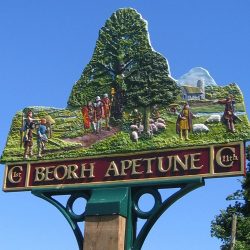Stand facing the south porch of Bergh Apton church and then turn and take three or four giant strides to your right and you will reach the north wall of the transept. The wall is made of flint and the quoins of limestone. A wall built of flint and rubble would have an uneven edge at the corner and wet and frosty weather would soon erode so quoins, which are cut blocks of stone, were used to give stability and protect. Today quoins are largely merely decorative. About four or five feet up on one of these quoins are groves, a few inches in length and radiating from a central point where the gnomon used to be, this would probably have been a nail and is long gone. The right hand side of the quoin was broken at some point so the lines on that side have nearly disappeared. I used to think this was what is sometimes known as a scratch dial, a simple sun dial. I am reading ‘Medieval Graffiti’ by Matthew Champion and I now know these are correctly called Mass Dials. The early ones were generally just straight lines but later ones included numerals and quite complex decoration. There are several thousand of them to be found in churches all over England. One theory is that they were used to show the approximate time of church services. In Mediaeval times life was planned between the rising and the setting of the sun and dominated by the Roman Catholic Church. Prayers were said through the day beginning at Matins which was before dawn and then Prime, Terce, Sext, None, Vespers which was at sunset and Nocturnes after sunset. As in our day church services were announced by the tolling of a bell so there was no need to put aside whatever task was in hand and hurry to the dial to see if it was time for a service. Some of these dials are found on the north wall of a church so of little use there. Dials were usually scratched near the porch of a church but some are found inside which would indicate the porch was a later addition. In some cases there are several of these dials scratched into the stonework and close together, why would several be needed? There is no real answer as to what these dials were really used for.
As far as I know no other examples of graffiti from six or seven hundreds of years ago can be found in Bergh Apton Church. So, in other ancient churches who scarred the walls? Was it perhaps the ploughman who scratched a fire breathing dragon on the wall in the nave? Did bored choir boys scratch demons and devils in the chancel? Perhaps the Lord of the Manor used his knife to write a love charm just inside the north door? Heraldic shields, knights, birds, fish, music, architectural plans all can be found. With the passing of time these graffiti now are worn but in Mediaeval times churches were brightly painted and must have been a joy to eye and mind and imagination and any angels and coats of arms and knights in armour and plants scratched through the paint to show the stone beneath would have been clearly visible and appear to have been respected and in some cases added to. Modern grafitti is generally a kicking of the voiceless against what is seen as an uncaring society, it is seen as undesirable but the graffiti of hundreds of years ago were perhaps a devotion, drawn and scratched by a people far more at home in their churches than many of our generation.
Pat Mlejnecky
